+Search query
-Structure paper
| Title | Structural mechanism of signal transduction in a phytochrome histidine kinase. |
|---|---|
| Journal, issue, pages | Nat Commun, Vol. 13, Issue 1, Page 7673, Year 2022 |
| Publish date | Dec 12, 2022 |
 Authors Authors | Weixiao Yuan Wahlgren / Elin Claesson / Iida Tuure / Sergio Trillo-Muyo / Szabolcs Bódizs / Janne A Ihalainen / Heikki Takala / Sebastian Westenhoff /   |
| PubMed Abstract | Phytochrome proteins detect red/far-red light to guide the growth, motion, development and reproduction in plants, fungi, and bacteria. Bacterial phytochromes commonly function as an entrance signal ...Phytochrome proteins detect red/far-red light to guide the growth, motion, development and reproduction in plants, fungi, and bacteria. Bacterial phytochromes commonly function as an entrance signal in two-component sensory systems. Despite the availability of three-dimensional structures of phytochromes and other two-component proteins, the conformational changes, which lead to activation of the protein, are not understood. We reveal cryo electron microscopy structures of the complete phytochrome from Deinoccocus radiodurans in its resting and photoactivated states at 3.6 Å and 3.5 Å resolution, respectively. Upon photoactivation, the photosensory core module hardly changes its tertiary domain arrangement, but the connector helices between the photosensory and the histidine kinase modules open up like a zipper, causing asymmetry and disorder in the effector domains. The structures provide a framework for atom-scale understanding of signaling in phytochromes, visualize allosteric communication over several nanometers, and suggest that disorder in the dimeric arrangement of the effector domains is important for phosphatase activity in a two-component system. The results have implications for the development of optogenetic applications. |
 External links External links |  Nat Commun / Nat Commun /  PubMed:36509762 / PubMed:36509762 /  PubMed Central PubMed Central |
| Methods | EM (single particle) |
| Resolution | 3.4 - 3.62 Å |
| Structure data | 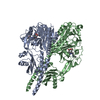 PDB-8avv: 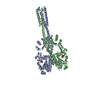 PDB-8avw: 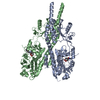 PDB-8avx: |
| Chemicals | 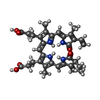 ChemComp-LBV: 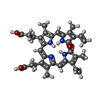 ChemComp-BLA: |
| Source |
|
 Keywords Keywords |  TRANSFERASE / TRANSFERASE /  KINASE / KINASE /  PHOTOSENSOR / PHOTOSENSOR /  PHYTOCHROME PHYTOCHROME |
 Movie
Movie Controller
Controller Structure viewers
Structure viewers About Yorodumi Papers
About Yorodumi Papers




